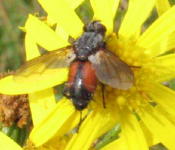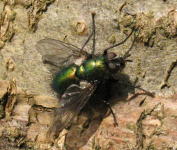TACHNID
MATRIX |
||
|

|
Tachnid Fly Tachina fera |

|
|
|
||
|
|
. |
. |
|
|
||
What are Tachinids Flies ?
Tachinids are flies - insects belonging to the insect order 'diptera' and have therefore two wings and, within that order, the superfamily 'Calyptrae' and family 'Tachinidae'. Their closest relatives are the house flies (Muscidae), 'blue-bottles' (Calliphopidae), 'flesh flies' (Sarcophagidae) and some smaller families - the Rhinophoridae and Oestridae.
Tachinids are generally refered to as ’Parasitic Flies’ because their dietary habit and feeding behaviour includes eating or feeding on bodies of adult invertebrates. Although denoted Parasites a better descriptor would be Parasitoids - the difference being that Parasites (like tapeworms) don’t kill their hosts, but parasitoids usually cause the death of the host in some way - either by killing them outright - or by weakening them so much that they die - or in the case of 'clepto-parasitoids', by eating the host's food.
Host Relationships
Many Tachnid flies attack the larval stages of the host - but a few have been known to start their attack at the egg, pupa or adult stages. Eggs are either: injected into the host with a sharp , dagger-like piercing organ (flies don't actually have an ovipositor, like some wasps); or laid on the skin of the host (often in places that are impossible for the host to reach and clean off); or they can even be laid in bulk on the host's food and can either jump onto a host as it walks past or enter the host's body through its gut when the egg is eaten.
The majority of species attack the larvae of butterflies & moths (Lepidoptera) but some groups specialise in attacking beetles (Coleoptera), true bugs and plant hoppers (Hemiptera), sawflies (Hymenoptera), and other orders. Interestngly, very few attack other flies.
Some Tachinids are highly adapted and specialise in attacking a single species of insect (e.g. Cadurciella tritaeniata, which attacks only Green Hairstreak butterfly (Callophrys rubi)) but most seem to have quite broad tastes. Typically, tachinids hunt for related hosts, matching a certain size and appearance; within a defined habitat; and a niche within that habitat. So, for instance: "large, hairy moth caterpillars that usually sit exposed on low-growing heathland vegatation" (a favourite of Tachina grossa, our biggest tachinid) OR "medium/large butterfly & moth caterpillars that usually sit under the leaves of deciduous trees along woodland edges".
In Britain they are aprox 260 species on the UK Checklist list and this number is constantly updated as new species are added each year. Most newcomers are species genuinely expanding their range from mainland Europe or which are very local in distribution or which are seldom encountered because you need to use unusual trapping methods (eg. Malaise Traps) to catch them.